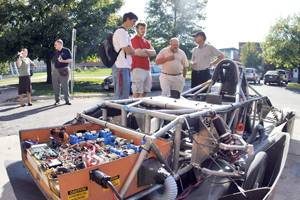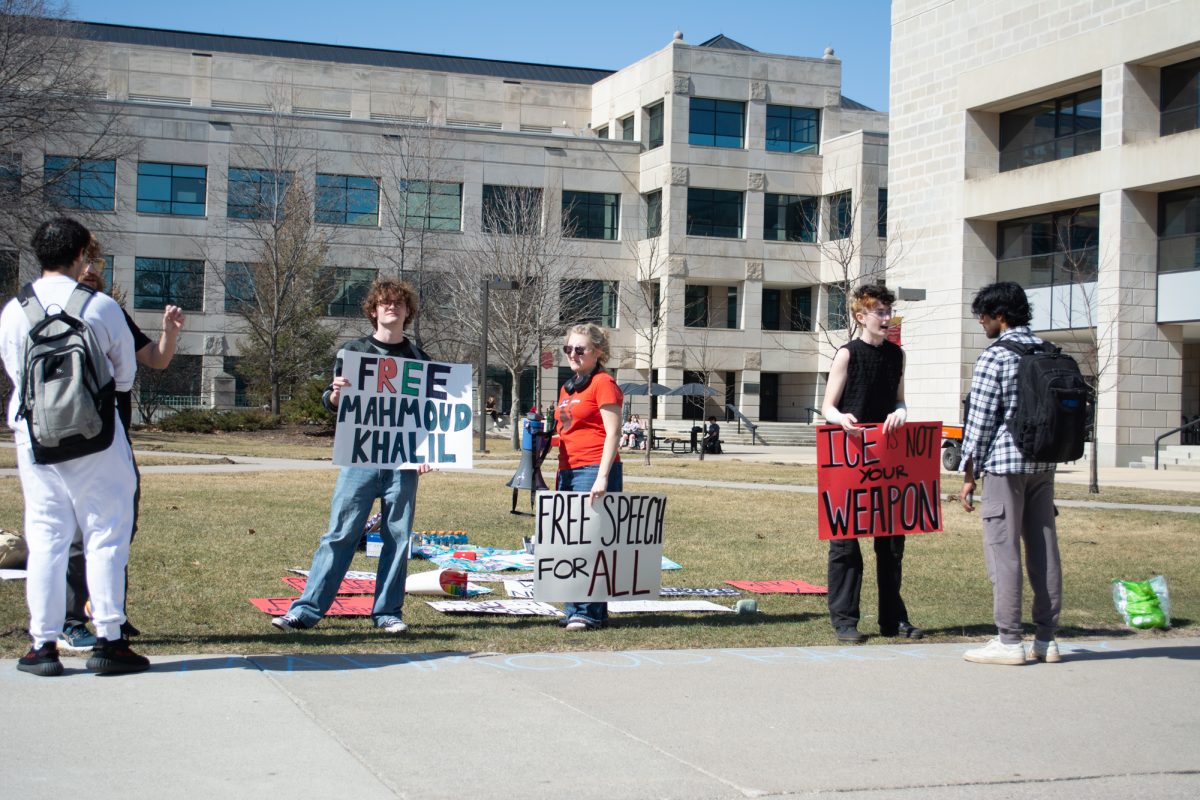Team PrISUm displays success

Darin Goza, from left, freshman in computer engineering, Evan Adkins, sophomore in computer engineering and Electrical Director for Team PrISUm, Tom Wessels, safety and security manager for Ames Lab, and Mark Murphy, COO for Ames Lab, share a conversation by the Team PrISUm solar car on Thursday, Sept. 18, 2008, by the Sweeney Hall garage. The car was on display as part of a public reception held by Team PrISUm. Photo: Kevin Zenz/Iowa State Daily
September 18, 2008
An ISU student-run solar car project placed eighth and displayed their car Thursday.
In the garage of Sweeney Hall on Thursday, an open house was held to display the solar race care for Team PrISUm. Students who drove and participated in the construction of the car were busy showing it off, which placed eighth this past summer in the North American Solar Challenge.
According to the North American Solar Challenge 2008 route map, the participating teams, including Iowa State, started in Plano, Texas, and crossed the finish line in Calgary, Alberta, Canada.
According to a press release, it took Team PrISUm a total of 91 hours and 12 minutes to finish the entire race.
The students of Team PrISUm have been busy putting together the solar car for the past 18 months, said Mike Steffen, PrISUm project director. Steffen explained how the solar car worked.
“It’s simply solar panels pouring their electricity into the batteries of the car that makes the car run,” Steffen said. “It’s basically an electrical car running off the sun’s energy.”
Erin Kelly, assistant project director, said this summer Team PrISUm was able to “show off their hard work.”
Kelly said the project was funded through donations of roughly 20 companies and 10 people, such as teachers and alumni.
“The only real reason we’re having this whole thing is to thank our sponsors for making donations of parts and time and, also, honor our team,” Kelley said.
Galen Thomas, owner of American Waterjet Cutting, said his company donated their time to help the team.
“They called us to see if we would cut some parts for them, so we volunteered our time,” Thomas said.
Ron Nelson, professor of mechanical engineering and advisor for the team, said it was a student-run project.
“The students did just about everything,” he said. “They’re super students.”
Nelson said the next race is about two years away and students are already getting prepared. He said thanks to the experienced returning students, the project will be a bigger success in the coming years.
Nelson also expressed that the team needed students from all majors, ranging from home economics to advertising, and advised all students to participate.
“They [students] should all come join the team and help out,” he said.
James Hill, university professor and department chair of chemical and biological engineering and another advisor for the team, said he actually started the solar car team in 1989. Hill said the reason he started the program was to get students more involved.
“It was great for the students, it was great for the school and also for the school image,” Hill said.
Hill also said the reason he got involved was because “it was an one-of-a-kind program.”






